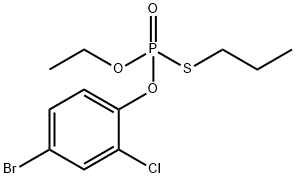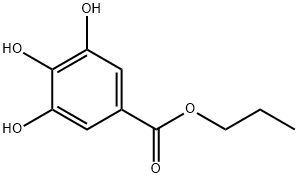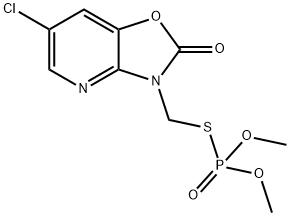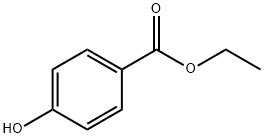Profenofos
- CAS NO.:41198-08-7
- Empirical Formula: C11H15BrClO3PS
- Molecular Weight: 373.63
- MDL number: MFCD00078736
- EINECS: 255-255-2
- SAFETY DATA SHEET (SDS)
- Update Date: 2025-01-27 09:38:02

What is Profenofos?
Description
Profenofos is a pale yellow liquid, bp 100 ?C/1.80 Pa, vp 0.124 mPa (25 ?C). Solubility in water is 28 mg/L (25 ?C). It is miscible with most organic solvents. Log Kow = 4.44. It is relatively stable in neutral and mild acid media but hydrolyzed in alkaline media; DT50 values (20 ?C) at pH 5, 7, and 9 are 93 d, 14.6 d, and 5.7 h, respectively.
Chemical properties
Profenofos is a pale yellow liquid. Profenofos is relatively
stable under neutral and slightly acidic conditions and unstable
under alkaline conditions.Profenofos has a garlic-like odor.
Profenofos has limited solubility in water
(28 mg/L at 25°C) but is completely soluble
in organic solvents (ethanol, acetone, toluene,
n-octanol and n-hexane) at 25°C.
The Uses of Profenofos
Profenofos is used to control insects (particularly caterpillars and Lepidoptera eggs) and mites on cotton, maize, sugar beet, soyabean, potatoes, vegetables, tobacco and a number of other crops
The Uses of Profenofos
A broad-spectrum organophosphorous pesticide that is used widely in cotton fields for insect control.
The Uses of Profenofos
Insecticide; acaricide.
What are the applications of Application
Profenofos is a useful chemical to study pesticide interactions with cell lines
Definition
ChEBI: Profenofos is an organic thiophosphate, an organophosphate insecticide, an organochlorine insecticide and a member of monochlorobenzenes. It has a role as an EC 3.1.1.7 (acetylcholinesterase) inhibitor, an acaricide and an agrochemical. It is functionally related to a 4-bromo-2-chlorophenol.
General Description
Pale yellow liquid with garlic-like odor. Corrosive. Used as an insecticide.
Air & Water Reactions
Hydrolyzed under alkaline conditions.
Reactivity Profile
Organophosphates are susceptible to formation of highly toxic and flammable phosphine gas in the presence of strong reducing agents such as hydrides. Partial oxidation by oxidizing agents may result in the release of toxic phosphorus oxides.
Agricultural Uses
Profenofos: Profenofos is A U.S. EPA restricted Use Pesticide (RUP) used solely on cotton to control a number of pests including tobacco budworm, cotton aphid and bollworm, armyworm, fleahopper and whiteflies. It is not registered for residential use. Not approved for use in EU countries. Registered for use in the U.S.
Trade name
CGA-15324®; CURACRON®; POLYCRON®; SELECRON®
Carcinogenicity
In a 2 year carcinogenicity study mice were given diets containing 0, 1, 30, or 100 ppm profenofos (equivalent to 0, 0.15, 4.5, or 15 mg/kg/day) for 85 weeks (males) or 97 weeks (females) . No treatment related clinical signs were observed. No treatment-related gross or microscopic lesions, tumors, or biologically significant differences in body weight or food consumption were observed between controls and profenofos-treated animals. Plasma and erythrocyte cholinesterase inhibition occurred at dose levels of 4.5 and 15 mg/kg/day. In another carcinogenicity study, rats were fed diets containing 0, 0.3, 10, or 100 ppm profenofos (equivalent to 0, 0.015, 0.5, or 5 mg/kg/day) for 2 years, and there was no increase in tumor incidence in any treated group compared to the control group .
Environmental Fate
Plant. Dislodgable residues of profenofos on cotton leaf 0, 24, 48, 72 and 96 hours
after application (1.1 kg/ha) were 3.5, 1.1, 0.74, 0.51 and 0.35 μg/m2, respectively (Buck
et al., 1980)
Photolytic. When profenofos in an aqueous buffer solution (pH 7.0) was exposed to
filtered UV light (λ >290 nm) for 24 hours at 25 and 50°C, 29 and 61% respectively
decomposed to 4-bromo-2-chlorophenol and 4-bromo-2-chlorophenyl ethyl hydrogen
ph
Chemical/Physical. Emits toxic fumes of bromine, chlorine phosphorus and sulfur
oxides when heated to decomposition (Sax and Lewis, 1987).
Metabolic pathway
The metabolic transformations of profenofos in plants and animals are similar and occur via hydrolysis to 4-bromo-2-chlorophenol which is then conjugated.
Metabolism
Profenofos orally administered to rats is rapidly excreted, mainly in the urine. The principal degradation route is hydrolysis to 4-bromo-2-chlorophenol followed by conjugation. DT50 in soil is about 1 week.
Degradation
Profenofos is stable under neutral and slightly acid conditions but it is hydrolysed in alkaline solution. The DT50 values at pH 5, 7 and 9 (20°C) were 93 days, 14.6 days and 5.7 hours, respectively (PM).
Toxicity evaluation
The acute oral LD50 for rats is 358 mg/kg. Inhalation LC50 (4 h) for rats is about 3 mg/L air. NOEL (2 yr) for rats is 0.3 mg/kg diet (0.015 mg/kg/d). ADI is 0.01 mg/kg b.w.
Properties of Profenofos
| Melting point: | <25 °C |
| Boiling point: | 110°C (0.001 torr) |
| Density | d20 1.455 |
| vapor pressure | 1.24×10-4 Pa (25 °C) |
| refractive index | n20D 1.5466 |
| Flash point: | 124℃ |
| storage temp. | APPROX 4°C
|
| solubility | DMSO: 50 mg/mL (133.82 mM) |
| form | Oily Liquid |
| Water Solubility |
28 mg l-1 (25 °C) |
| Specific Gravity | 1.455 (20℃) |
| color | Colorless to light yellow |
| Merck | 13,7860 |
| BRN | 2150258 |
| CAS DataBase Reference | 41198-08-7(CAS DataBase Reference) |
| NIST Chemistry Reference | Phosphorothioic acid, o-(4-bromo-2-chlorophenyl) o-ethyl s-propyl ester(41198-08-7) |
| EPA Substance Registry System | Profenofos (41198-08-7) |
Safety information for Profenofos
| Signal word | Warning |
| Pictogram(s) |
 Exclamation Mark Irritant GHS07  Environment GHS09 |
| GHS Hazard Statements |
H317:Sensitisation, Skin H410:Hazardous to the aquatic environment, long-term hazard |
| Precautionary Statement Codes |
P261:Avoid breathing dust/fume/gas/mist/vapours/spray. P273:Avoid release to the environment. P280:Wear protective gloves/protective clothing/eye protection/face protection. P301+P312:IF SWALLOWED: call a POISON CENTER or doctor/physician IF you feel unwell. |
Computed Descriptors for Profenofos
New Products
Methyl (R)-1-Boc-4,4-difluoropyrrolidine-2-carboxylate 2,2-Difluoropropylamine hydrochloride tert-butyl 3-bromoazetidine-1-carboxylate (R)-1-Boc-3-hydroxypyrrolidine DIFLUOROACETIC ANHYDRIDE 2,2-Difluoropropionic acid Diallylamine, 99% Calcium hydroxide, 95% Aluminum oxide, basic 2-Bromophenylacetonitrile, 97% L-tert-Leucine,97% N-Hydroxy-2-methylpropanimidamide 4-(3,4-Dichlorophenyl)-3,4-Dihydro-N-Methyl-1-(2H)-Naphthalenimine (Schiff Base) 2-AMINO-3,5-DIBROMO BENZALDEHYDE [ADBA] L-Glutamic Acid Dimethyl Ester Hcl 10-Methoxy-5H-dibenz[b,f]azepine 5-Cyanophthalide N, N-Carbonyldiimidazole (CDI) Dibenzoyl Peroxide Titanium Dioxide 2-(Methylthio) Benzonitrile Sodium Acetate Anhydrous Allopurinol 1,5-DibromopentaneRelated products of tetrahydrofuran








You may like
-
 41198-08-7 99%View Details
41198-08-7 99%View Details
41198-08-7 -
 41198-08-7 Profenofos 98%View Details
41198-08-7 Profenofos 98%View Details
41198-08-7 -
 Profenofos CAS 41198-08-7View Details
Profenofos CAS 41198-08-7View Details
41198-08-7 -
 Profenofos 41198-08-7 99%View Details
Profenofos 41198-08-7 99%View Details
41198-08-7 -
 Profenofos 98%View Details
Profenofos 98%View Details
41198-08-7 -
 Profenofos 41198-08-7 98%View Details
Profenofos 41198-08-7 98%View Details
41198-08-7 -
 Profenofos CAS 41198-08-7View Details
Profenofos CAS 41198-08-7View Details
41198-08-7 -
 Profenofos CAS 41198-08-7View Details
Profenofos CAS 41198-08-7View Details
41198-08-7
